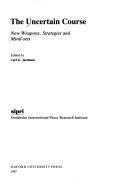| Listing 1 - 10 of 15 | << page >> |
Sort by
|
Book
Year: 1967 Publisher: Englewood Cliffs, N.J. : Prentice-Hall,
Abstract | Keywords | Export | Availability | Bookmark
 Loading...
Loading...Choose an application
- Reference Manager
- EndNote
- RefWorks (Direct export to RefWorks)
Weapons systems --- Weapons industry --- Systèmes d'armes --- United States --- Etats-Unis --- Defenses --- Défense
Book
Year: 1961 Publisher: [Washington, D.C.] : [U.S. Department of the Army],
Abstract | Keywords | Export | Availability | Bookmark
 Loading...
Loading...Choose an application
- Reference Manager
- EndNote
- RefWorks (Direct export to RefWorks)
Soldiers --- Ability testing --- United States. --- États-Unis. --- Personnel management. --- Weapons systems. --- Systèmes d'armes.
Book
ISBN: 090049297X Year: 1976 Volume: 126 Publisher: London : International Institute for Strategic Studies,
Abstract | Keywords | Export | Availability | Bookmark
 Loading...
Loading...Choose an application
- Reference Manager
- EndNote
- RefWorks (Direct export to RefWorks)
Ordnance --- Weapons systems --- Matériel de guerre --- Systèmes d'armes --- Weapon systems --- Engineering systems --- Military weapons --- Cannon --- Guns --- Artillery --- Matériel de guerre --- Systèmes d'armes

ISBN: 0874366844 Year: 1995 Publisher: Santa Barbara, Calif. : ABC-Clio,
Abstract | Keywords | Export | Availability | Bookmark
 Loading...
Loading...Choose an application
- Reference Manager
- EndNote
- RefWorks (Direct export to RefWorks)
Persian Gulf War, 1991 --- Weapons systems --- Guerre du golfe Persique, 1991 --- Systèmes d'armes --- Equipment and supplies --- Chronology --- Appareils et matériel --- Chronologie
Book
ISBN: 9782233010193 Year: 2022 Publisher: Paris : Éditions Pedone,
Abstract | Keywords | Export | Availability | Bookmark
 Loading...
Loading...Choose an application
- Reference Manager
- EndNote
- RefWorks (Direct export to RefWorks)
Guerre --- Art et science militaires --- Armes de guerre --- Systèmes d'armes létales autonomes --- Sécurité internationale. --- Aspect moral. --- Innovations technologiques. --- Droit.

ISBN: 0198291159 Year: 1987 Publisher: New York Oxford University press
Abstract | Keywords | Export | Availability | Bookmark
 Loading...
Loading...Choose an application
- Reference Manager
- EndNote
- RefWorks (Direct export to RefWorks)
Polemology --- Armes [Systèmes d' ] --- Systèmes d'armes --- Wapensystemen --- Weapon systems --- Weapons systems --- Military art and science --- Art et science militaires --- History --- Histoire --- Systèmes d'armesHistory --- Systèmes d'armes --- 20th century
Book
ISBN: 9780674073012 Year: 2013 Publisher: Cambridge, Mass. Belknap Press of Harvard University Press
Abstract | Keywords | Export | Availability | Bookmark
 Loading...
Loading...Choose an application
- Reference Manager
- EndNote
- RefWorks (Direct export to RefWorks)
Robert Neer has written the first history of napalm, from its inaugural test on the Harvard College soccer field, to a Marine Corps plan to attack Japan with millions of bats armed with tiny napalm time bombs, to the reflections of Phan Thi Kim Phuc, a girl who knew firsthand about its power and its morality.
International relations. Foreign policy --- Polemology --- anno 1900-1999 --- anno 2000-2009 --- United States --- Napalm --- Incendiary weapons --- Incendiary bombs --- Armes incendiaires --- Bombes incendiaires --- History --- Histoire --- Etats-Unis --- Armed Forces --- Weapons systems --- Forces armées --- Systèmes d'armes --- Forces armées --- Systèmes d'armes --- History. --- United States of America
Book
ISBN: 9781316607657 9781107153561 9781316597873 1316607658 Year: 2016 Publisher: Cambridge: Cambridge university press,
Abstract | Keywords | Export | Availability | Bookmark
 Loading...
Loading...Choose an application
- Reference Manager
- EndNote
- RefWorks (Direct export to RefWorks)
The intense and polemical debate over the legality and morality of weapons systems to which human cognitive functions are delegated (up to and including the capacity to select targets and release weapons without further human intervention) addresses a phenomena which does not yet exist but which is widely claimed to be emergent. This groundbreaking collection combines contributions from roboticists, legal scholars, philosophers and sociologists of science in order to recast the debate in a manner that clarifies key areas and articulates questions for future research. The contributors develop insights with direct policy relevance, including who bears responsibility for autonomous weapons systems, whether they would violate fundamental ethical and legal norms, and how to regulate their development. It is essential reading for those concerned about this emerging phenomenon and its consequences for the future of humanity.
Military weapons --- Robotics --- Weapons systems. --- War --- Arms race --- LAW / International. --- Law and legislation. --- Technological innovations --- Moral and ethical aspects. --- Law / international. --- Autonomous weapons systems (International law) --- Systèmes d'armes létales autonomes --- Armes de guerre --- Guerre --- Course aux armements --- Droit. --- Innovations technologiques --- Aspect moral. --- Systèmes d'armes létales autonomes
Book
ISBN: 9781108499743 9781108731225 9781108584654 Year: 2020 Publisher: Cambridge Cambridge University Press
Abstract | Keywords | Export | Availability | Bookmark
 Loading...
Loading...Choose an application
- Reference Manager
- EndNote
- RefWorks (Direct export to RefWorks)
"Militarily advanced States are devoting significant resources to develop increasingly autonomous weapons for use in armed conflict. The prospect of 'killer robots' being deployed on future battlefields has sparked controversy and has led to efforts by the United Nations and other bodies to regulate their development and use. Much opposition to autonomous weapons has been based on the beliefs that their use would violate international humanitarian law and that an 'accountability gap' would mean that nobody could be held responsible when a robot breaks the law. Drawing on a mixture of technical and legal sources, this book demonstrates that IHL as it stands today can adequately regulate use of autonomous weapons. Individual forms of accountability may be less effective though, and a focus on collective accountability would be beneficial. The book explores the interface between the technologies of weapon autonomy and the principles and rules of IHL. It discusses the impact of autonomous weapons on rules of weapons law, targeting law and accountability regimes. It offers suggestions for ensuring accountability and for advancing the international debate about regulatory responses"--
MILITARY ROBOTS--LAW AND LEGISLATION --- ROBOTS--MILITARY APPLICATIONS --- HUMANITARIAN LAW --- Autonomous weapons systems (International law) --- Systèmes d'armes létales autonomes --- Humanitarian law --- Military robots --- War (International law) --- Droit humanitaire --- Robots militaires --- Guerre (droit international) --- Systèmes d'armes létales autonomes
Book
ISBN: 9789004449077 9789004449084 Year: 2021 Publisher: Leiden;Boston Brill | Nijhoff
Abstract | Keywords | Export | Availability | Bookmark
 Loading...
Loading...Choose an application
- Reference Manager
- EndNote
- RefWorks (Direct export to RefWorks)
"The deployment of Autonomous Weapons gives rise to ongoing debate in society and at the United Nations, in the context of the Convention on Certain Conventional Weapons. Yet little empirical research has been done on this topic. This volume fills that gap by offering an empirical study based on military personnel and civilians working at the Dutch Ministry of Defence. It yields insight into how Autonomous Weapons are perceived by the military and general public; and which moral values are considered important in relation to their deployment. The research approach used is the Value-Sensitive Design (VSD) method that allows for the consideration of human values throughout the design process of technology. The outcome indicates that military personnel and civilians attribute more agency (the capacity to think and plan) to an Autonomous Weapon than to a Human Operated Drone. In addition, it is clear that common ground exists between military and societal groups in their perception of the values of human dignity and anxiety. These two values arise often in the discourse, and addressing them is essential when considering the ethics of the deployment of Autonomous Weapons. The text of this volume is also offered in parallel French and German translation"--
Autonomous weapons systems --- Military weapons --- Moral and ethical aspects --- Technological innovations --- Technological innovations&delete& --- Armaments --- Combat weapons --- Instruments of war --- Munitions --- Military supplies --- Weapons --- Disarmament --- Weapons systems --- Systèmes d'armes létales autonomes --- Armes de guerre --- Moral and ethical aspects. --- Aspect moral. --- Pays-Bas. --- AUTONOMOUS WEAPONS SYSTEMS--MORAL AND ETHICAL ASPECTS--NETHERLANDS --- Systèmes d'armes létales autonomes
| Listing 1 - 10 of 15 | << page >> |
Sort by
|

 Search
Search Feedback
Feedback About UniCat
About UniCat  Help
Help News
News